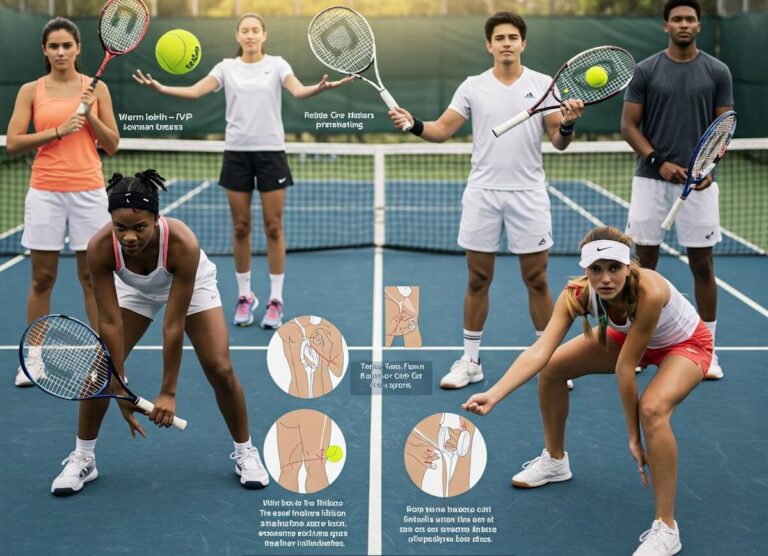Introduction to Footwork in Tennis
Footwork is a fundamental aspect of tennis that significantly influences a player’s overall performance on the court. The ability to move efficiently is critical, as tennis is a sport that requires rapid directional changes, precise positioning, and seamless transitions between offensive and defensive strategies. Effective footwork allows players to maintain balance while executing shots, thereby enhancing their ability to strike the ball accurately and powerfully.
Agility, speed, and balance are three key components derived from proficient footwork. Agility is the ability to change direction quickly without losing speed, which is crucial when responding to an opponent’s shot. By mastering footwork techniques, players can improve their agility, enabling them to reach balls with greater ease and confidence. Speed, on the other hand, pertains to the quickness of movement across the court. Optimal footwork facilitates faster reactions and better anticipation of the ball, allowing for timely shot execution.
Balance is equally vital in ensuring that a player is stable during their strokes. Whether playing from the baseline or approaching the net, maintaining proper foot positioning helps in generating power and control. This foundation enhances a player’s shot accuracy and overall court coverage, essential for effectively returning serves or executing groundstrokes. Additionally, the role of footwork extends beyond individual performance; it is integral to court positioning during exchanges. Players with well-developed footwork can navigate the court seamlessly, moving into optimal positions to execute both offensive and defensive plays.
In conclusion, mastering footwork is essential for any tennis player aiming to elevate their game. By focusing on the principles of agility, speed, and balance, players can unlock their full potential and achieve more effective performance on the court.
Understanding the Mechanics of Footwork
Footwork in tennis is a critical aspect that encompasses the biomechanics of movement, enabling players to position themselves optimally for various strokes. Effective footwork involves a combination of lateral movements, quick bursts of speed, and precise positioning, all of which are essential for maintaining balance and control during both aggressive and defensive play. Mastering these elements not only enhances performance but also plays a significant role in minimizing the risk of injury.
Lateral movements are a fundamental component of tennis footwork, allowing players to shift quickly from side to side. This agility is crucial when covering the court, especially when responding to angled shots. The ability to move laterally involves the coordinated action of the legs, hips, and core, ensuring that players can maintain a stable base while preparing to strike the ball. Practicing drills that emphasize lateral movement can help build muscle memory, which is integral to ensuring swift responses during matches.
Beyond lateral movements, quick bursts of speed are essential, especially during points when a player needs to approach the net or reposition themselves after a deep return. Proper footwork techniques, such as the split step, enable players to launch into action from a stationary position. This effective transition not only speeds up their response time but also enhances their balance, allowing for more powerful and accurate shots.
Additionally, understanding positioning for various strokes is vital. Each stroke requires a different stance and foot placement to optimize power and accuracy. Whether it is a backhand, forehand, or serve, proper footwork allows players to execute these shots with greater efficiency. Furthermore, good footwork contributes to maximizing endurance on the court, reducing fatigue over time. Consequently, players who focus on refining their footwork mechanics can expect both improved gameplay and a reduced likelihood of injury.
The Connection Between Footwork and Stroke Production
In tennis, mastering footwork is intricately linked to the efficacy of stroke production and shot placement. The ability to move with agility and precision not only enables players to reach the ball but also plays a critical role in executing effective strokes such as the forehand, backhand, and serve. When players establish correct foot positioning, they gain a substantial advantage by allowing themselves to create optimal angles, enhance timing, and therefore increase the likelihood of successful shots.
Regarding the forehand stroke, a player’s footwork sets the foundation for generating power and spin. By positioning the feet correctly and utilizing lateral movements, a player can pivot efficiently, leading to a more controlled and powerful forehand. Good footwork ensures that the player can transfer weight seamlessly from the back foot to the front foot, resulting in an explosive shot that targets the intended area of the court.
Similarly, footwork is vital for executing an effective backhand stroke. Whether playing two-handed or one-handed backhand, a stable stance and appropriate lateral movement allow players to achieve better balance and control. Correctly moving into position not only aids in striking the ball cleanly but also allows players to maintain proper posture, which is essential for accuracy and consistency.
Moreover, when considering serving, the role of footwork cannot be overstated. The serve requires a rhythmic movement that begins with the feet and ultimately dictates the motion of the upper body. A strong stance is key for generating power and establishing a solid base. Players who utilize efficient footwork during the serve can improve their positioning and rhythm, leading to effective shot placement and greater success on the court.
Ultimately, the connection between footwork and stroke production is undeniable. Enhanced footwork not only aids in controlling strokes but also translates into smarter plays and strategic shot selections, positively impacting a player’s overall performance in tennis.
Key Footwork Drills for Improvement
Effective footwork is a cornerstone of success in tennis, enabling players to position themselves optimally for each shot. Implementing targeted drills can significantly improve agility, balance, and overall movement on the court. Below are several essential footwork drills that every player should consider integrating into their training routines.
One fundamental drill is the ladder drill, which enhances agility and foot speed. Players can use an agility ladder laid out flat on the ground. The objective is to move through the ladder by placing one foot in each square while maintaining a quick pace. This drill can be modified by incorporating side steps or backward movements to engage different muscle groups. Consistent practice of the ladder drill will result in faster footwork and improved reaction times during matches.
Another effective exercise is the side shuffle. This drill requires players to position themselves in a ready stance and shuffle laterally across the court. The key is to maintain a low center of gravity while engaging the proper lateral movement. Practicing side shuffles enhances the ability to cover the court efficiently, allowing players to respond swiftly to their opponent’s shots.
Additionally, the cone drill focuses on explosive movement and changes of direction. Players should set up five cones in a zigzag pattern. Starting from a centralized position, players sprint to the first cone, touch it, and then quickly pivot to the next cone, repeating the process. This drill emphasizes reaction time, confidence in movement, and the ability to quickly adjust positioning when approaching the ball.
Incorporating these drills into regular practice not only enhances agility but also builds muscle memory, providing players with the tools necessary to execute precise footwork during competitive play. By investing time in these key exercises, athletes can unlock their potential and achieve greater performance on the court.
Footwork Strategies for Different Playing Styles
In tennis, mastering footwork is crucial for executing successful shots and maintaining a competitive edge on the court. Different playing styles, such as baseliners and serve-and-volleyers, necessitate tailored footwork strategies to maximize effectiveness. Understanding these distinct approaches can enhance a player’s ability to adapt their movements based on their style and opponent’s tactics.
For baseliners, who typically dominate from the back of the court, footwork revolves around lateral movement and positioning. These players must focus on staying low and balanced to ensure they can quickly adjust to incoming shots. Practicing side-to-side shuffles and incorporating crossover steps can help baseliners maintain their rhythm and create opportunities for aggressive shots. Emphasizing the importance of anticipating the opponent’s return also plays a critical role, allowing them to position themselves well for the next strike.
Serve-and-volley players, on the other hand, require a different set of footwork skills, as their strategy involves moving quickly towards the net after a serve. Developing explosive acceleration and a strong first step is essential for them. Players should focus on improving their split step timing, which allows them to react quickly to the opponent’s return. Additionally, practicing forward movement drills will enhance their ability to cut angles effectively and close the distance to the net while maintaining balance.
Moreover, players who incorporate transitions between styles will benefit from blending the strategies mentioned above. For instance, a player might adopt baseline techniques during rallies while preparing to serve and volley when opportunities arise. This adaptability is vital as it keeps opponents guessing and provides a strategic advantage. By recognizing their playing style and implementing focused footwork strategies, players can ultimately unlock their full potential on the tennis court.
Mental Aspects of Footwork in Tennis
The mental components of footwork in tennis play a crucial role in enhancing performance on the court. Anticipation is one of the key mental skills that players must develop to improve their footwork. Tennis is a fast-paced sport, and the ability to predict an opponent’s next move allows players to position themselves effectively. By studying their opponents’ patterns and visual cues, players can cultivate a keen sense of anticipation, enabling swift and accurate movements in response to the game’s dynamics.
Focus is another essential aspect that influences footwork. In the heat of match play, distractions can significantly impede a player’s ability to execute precise footwork. Maintaining concentration allows players to better gauge the timing required for each shot and the appropriate foot placement. Practicing mindfulness techniques, such as deep breathing and visualization, can foster improved concentration and help players remain present during intense moments in the game.
Decision-making also significantly impacts footwork in tennis. Players must rapidly assess their options and choose the best course of action, which requires mental agility. The integration of tactic and instinct is crucial in these split-second decisions, often determining the success of a point. Incorporating drills that simulate match pressure can help players train their decision-making skills, enabling them to internalize the necessary footwork techniques and execute them under stress.
Overall, developing a robust mental game is as important as honing physical footwork skills. By enhancing anticipation, focus, and decision-making abilities, players can gain a competitive advantage on the court. As they learn to harness these mental aspects, they can experience a significant improvement in their ability to navigate complex gameplay situations. Thus, the symbiosis of mental resilience and physical dexterity can lead to superior footwork, ultimately unlocking a player’s true potential in tennis.
Common Footwork Mistakes and How to Avoid Them
Footwork is a critical component of tennis that encompasses not just movement but also proper positioning and balance on the court. Many players, regardless of their skill level, often fall into common footwork traps which can hinder their performance. One of the primary mistakes involves improper weight distribution. This issue arises when players are either too far forward or backward during their shots, leading to a lack of balance. To combat this, players should focus on maintaining an athletic stance, with weight evenly distributed on the balls of their feet, allowing for quick lateral and forward movements.
Another frequent mistake is the lack of readiness, which can severely impact a player’s ability to respond effectively to their opponent’s shots. Many players stand too flat-footed, making it challenging to react quickly. To improve readiness, players should practice staying on their toes, adopting a dynamic posture that prepares them for immediate movement. Engaging in drills that emphasize quick directional changes can also reinforce this aspect of footwork.
Inefficient movement patterns represent another significant area where players can improve. Often, players take unnecessary steps to reach the ball, wasting valuable time and energy. To eliminate this, players should work on their footwork drills that promote shorter, more purposeful steps. By emphasizing the importance of positioning—using outside foot to pivot, for instance—players can optimize their movement towards the ball.
Recognizing these common footwork errors is the first step towards improvement. Players should actively analyze their movement patterns during practice and matches. Consult with a coach or partner for feedback and employ targeted exercises that reinforce proper footwork techniques. This strategy will not only enhance overall performance but also contribute to better court coverage and shot execution.
Incorporating Footwork into Your Overall Training Regimen
Integrating footwork training into a comprehensive tennis practice routine is essential for any aspiring player. The significance of footwork in tennis cannot be overstated, as it directly affects a player’s agility, balance, and shot execution. A well-rounded training regimen must encompass a variety of skills, including serving, backhand, forehand, and especially footwork drills to develop a successful game.
To effectively incorporate footwork training into your routine, begin by assessing your current skill level and identifying areas for improvement. Schedule dedicated footwork drills at least two to three times a week, ensuring they are balanced with other technical and tactical training. For instance, during practice sessions, allocate specific time blocks for footwork exercises, such as ladder drills, cone sprints, or shadowing movements that mimic match-play scenarios.
Incorporating footwork drills into practice does not require separate sessions. Instead, integrate these exercises seamlessly with other components of your training. For example, after completing a series of service practice, spend 10 to 15 minutes on lateral movements, focusing on the key aspects of positioning and speed. This combination helps reinforce effective movement patterns while enhancing your overall skills on the court.
Moreover, utilize match-play scenarios to reinforce the importance of footwork. Engage in practice matches while consciously emphasizing proper footwork techniques. This practice not only helps in applying the skills learned through drills but also improves on-court decision-making. As you become more comfortable with your footwork, you will notice an increase in your ability to position effectively for shots, thus elevating your overall performance.
Ultimately, establishing a structured practice routine that addresses footwork is crucial. By diligently incorporating footwork training with other skill sets, players can refine their abilities and significantly enhance their game. A holistic approach to training ensures that each aspect of your game works harmoniously, enabling you to reach your full potential on the tennis court.
Conclusion: The Path to Improved Footwork and Performance
As we have explored throughout this discussion, mastering footwork is a fundamental aspect of elevating one’s performance in tennis. Footwork does not merely enhance a player’s mobility on the court; it contributes significantly to their overall game strategy. The ability to move swiftly and efficiently enables athletes to position themselves optimally for each shot, ensuring that they can respond effectively to their opponent’s actions. Thus, the importance of developing solid footwork cannot be overstated for players at all levels.
Continuous practice and dedication to refining footwork skills is essential. Engaging in specific drills that emphasize agility, balance, and quick directional changes will not only improve a player’s movement but also build muscle memory. Incorporating footwork exercises into regular training routines ensures that players become more adept at navigating the court, ultimately leading to enhanced performance during matches. Each session dedicated to footwork is an investment in one’s broader tennis capabilities, yielding rewarding improvements over time.
Moreover, the persistence required to master footwork will translate into greater confidence on the court. Players who feel assured in their ability to move fluidly will likely exhibit enhanced decision-making skills and a stronger presence during competitive play. It is this combination of physical proficiency and mental strength that allows a player to compete at higher levels.
In summary, by prioritizing footwork and treating it as a cornerstone of tennis practice, players can unlock their full potential. Regardless of current skill level, the commitment to improving footwork can pave the way for significant advancements in performance. Embracing this journey of continuous improvement will lead to not only better individual results but a greater enjoyment of the game itself.



